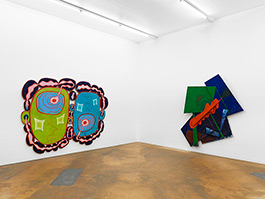
 |
|
From left to right: |
| français I english |
| October 12, 2016—January 29, 2017 |
|
Elizabeth Murray |
Elizabeth Murray (b. 1940, Chicago; d. 2007, New York) belongs to a generation of American painters who had to come to terms with the legacies of Abstract Expressionism, Pop art, and Minimalism. Murray studied in Chicago and California before settling in New York at the end of the 1960s. These different artistic contexts fed to her work, and helped her question the relations between painter and subject, as well as between the painting and its surrounding space. Her work emerged in the early 1970s at a time when modern painting was being challenged. She was in contact with a generation of artists including Brice Marden, Joel Shapiro, and Jennifer Bartlett, and first started her compositions with elementary yet ambiguous shapes, wavering between figurative and abstract. These motifs were then deployed on monumental formats with irregular contours. Influenced by Frank Stella’s “shaped canvases” and Lee Bontecou’s mural sculptures, Murray’s painting seems to be constantly transforming. It literally detaches itself from the wall to assert its own materiality and interact with the viewer. The composition’s dynamism and the colors’ vitality bring these abstract works on a more eccentric terrain than most of her contemporaries did. |
This exhibition is curated by Samuel Gross and benefits from the support of Gallery Pace, New York, and Maria Bernheim Galerie, Zurich. |
|
|